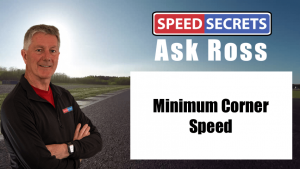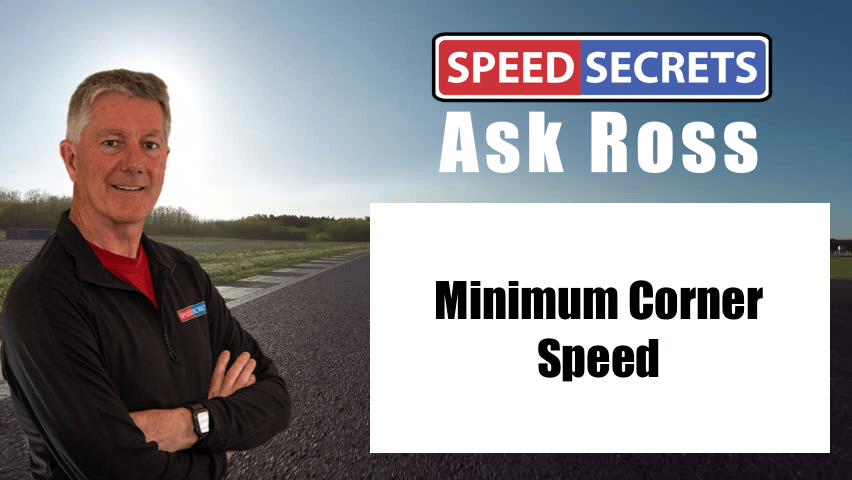 Q: “I have a question not about corner entry speed but rather about MID-corner speed (minimum corner speed). A friend of mine and I compare lots of data when we go to DE’s. He drives a nearly stock 987 Cayman S, is a pretty good driver, and runs tires he can get 30 track days out of. I drive a 718 Spyder with quite a bit of negative camber, Michelin Cup 2s, and have to replace tires every 6-10 track days — fronts more frequently than rears. I feel more comfortable with the car moving around than my friend does, and very comfortably trail brake as needed to balance/rotate the car. I have more grip, more power, and I do turn faster laps, BUT… his mid-corner speeds (or minimum speed in the corner) are sometimes equal to mine! That shouldn’t be the case. What am I doing wrong? Am I just being a wimp? Or does it go deeper than that? I generally brake VERY hard and VERY late and do a lot of trail braking (I go through brakes faster than anyone else I know). Is that part of the problem? Am I overworking my front tires? I record and analyze my tire temps after every session and pay attention to which end of the car I’m ‘overworking’ (determined by tire temps). Throughout any given day, I tend to transition from overworking the fronts to overworking the rears — it’s not significant in either direction, but that’s my trend. Can you help figure out if I’m being too cautious, or if I’m doing something else wrong?”
Q: “I have a question not about corner entry speed but rather about MID-corner speed (minimum corner speed). A friend of mine and I compare lots of data when we go to DE’s. He drives a nearly stock 987 Cayman S, is a pretty good driver, and runs tires he can get 30 track days out of. I drive a 718 Spyder with quite a bit of negative camber, Michelin Cup 2s, and have to replace tires every 6-10 track days — fronts more frequently than rears. I feel more comfortable with the car moving around than my friend does, and very comfortably trail brake as needed to balance/rotate the car. I have more grip, more power, and I do turn faster laps, BUT… his mid-corner speeds (or minimum speed in the corner) are sometimes equal to mine! That shouldn’t be the case. What am I doing wrong? Am I just being a wimp? Or does it go deeper than that? I generally brake VERY hard and VERY late and do a lot of trail braking (I go through brakes faster than anyone else I know). Is that part of the problem? Am I overworking my front tires? I record and analyze my tire temps after every session and pay attention to which end of the car I’m ‘overworking’ (determined by tire temps). Throughout any given day, I tend to transition from overworking the fronts to overworking the rears — it’s not significant in either direction, but that’s my trend. Can you help figure out if I’m being too cautious, or if I’m doing something else wrong?”
A: Interesting question! I’ll write as I think about this, and just give you some points to consider:
- Often, the difference in min speeds between cars do not vary that much, with the exception of very fast corners with car that have aero downforce. For example, the GT cars that run in IMSA often have equal – and sometimes even better – min speed than the prototype (DPi and LMP2) cars (except in the fast, downforce corners). As you know, the prototype cars turn much faster lap times, though.
- The way you describe your driving style, it seems like what I’d call a “point and shoot” style. What I mean is that you focus on late braking, getting the car turned with trail braking/rotating the car, and then – while you don’t specifically mention this – get strong exits out of the corner. With that style, often min speeds will not be as fast as a driver who uses what I’ll call a “momentum” style. It’s possible to turn the same lap time with each style; it’s also possible one style will suit a particular car and track better than another (in which case, that would be the fastest style in that specific situation). In other words, there’s nothing wrong with either… when it’s appropriate. By the way, one indication of the point and shoot style is going through brakes quickly! In racing, this style is effective in shorter races where brake life is a non-issue, but not as good in endurance races.
- In a sprint race, I hate trying to pass point and shoot drivers like you because I can’t pass in the brake zones (because of your late braking), I lose my momentum mid-corner because I’m behind you, and you get good exits out of the corners. I don’t mind racing you in an endurance race because I know you’re going to use up your tires and brakes, so I’ll eventually get past you. In endurance races, I dislike having co-drivers like you because you use up the brakes and tires, and I have to use them later in the race! So, in a sprint race, I like to use the point and shoot style, and in endurance races I use a momentum style.
- The point and shoot style, by its very definition, does not have as high min speeds as a more momentum style will. In your situation, if you and your friend swapped cars, you may find that he still has higher min speeds than you, and the gap in lap times may stay nearly the same (but with him being the faster one). Again, you may drive his car with your style, and he’d drive your car with his style.
- Can you increase your min speeds with a point and shoot style, and be even faster? Okay, now you’re really looking for more! Possibly. It may be that your min speeds are as high as they can be with your current style. But, in my world, there’s always more, so maybe you could eke out just a tiny bit more min speed without hurting your braking, entry and exit. Maybe. Maybe not.
- A challenge for you is to learn a new style of driving. Maybe you want to focus on learning to go just as fast, or maybe faster, using a momentum style? To do that, start by braking slightly earlier, possibly a bit lighter, and therefore flowing more speed into corners. I’m not talking 10 MPH, here, but just, let’s say 2-3 MPH more. Be a little smoother and slower with your brake release (but starting to release sooner, so your EoB is about the same), and that will help you carry more speed into the corner because the car will be better balanced (not so loaded up on the front tires, possibly not overworking them as much). And the goal is to begin applying the throttle in about the same place as before, but now from that slightly higher min speed. That would be more of a momentum style.
- If you do work at learning to use a momentum style, be prepared for a “one step backward to take two steps forward” kind of thing. In other words, your lap times may actually get slower for a while as you learn how to adapt your style, but then eventually get back to where they were before (or slightly slower or faster).
- Keep in mind that practically every track has corners that reward a momentum style, and other corners that reward a point and shoot style. So, by learning this momentum style, and then using both – each where appropriate – you may find yourself turning much faster lap times.
- Also keep in mind what your overall goals/objectives are. If you’re participating in DE events, I don’t think there are any trophies to be won, and big loads of prize money given for the fastest lap times!
- The fact that tire temps are pointing to “overworking” (or just “working”) both the fronts and rears throughout a day tells me that you’re likely driving your car at or near the limit.
Okay, that should get you thinking and give you something to work with.

